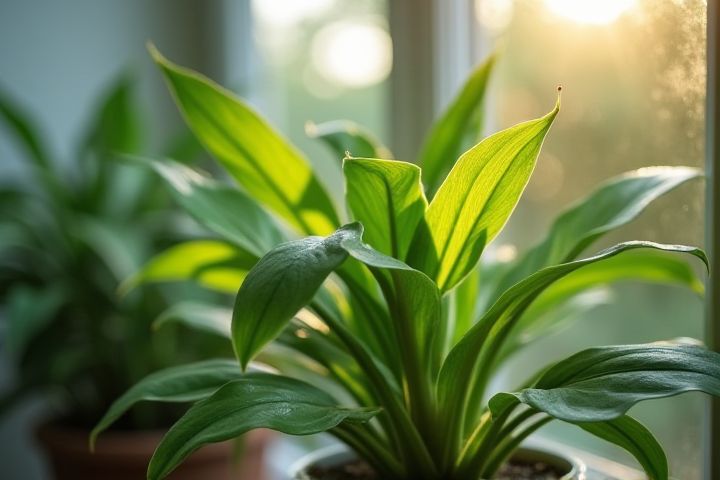
Several houseplants are recognized for their ability to improve indoor air quality by filtering pollutants and producing oxygen. The Snake Plant, known for its hardy nature, can remove toxins like formaldehyde and benzene while thriving in low light conditions. The Spider Plant is another excellent choice, effective in reducing carbon monoxide and producing oxygen, making it ideal for homes and offices alike. Aloe Vera not only helps purify the air but also offers healing properties with its succulent leaves. Finally, peace lilies efficiently remove various harmful substances, including ammonia, while adding a touch of elegance to your indoor spaces.
Which House Plants Improve Air Quality
Snake Plant
The Snake Plant, scientifically known as Sansevieria trifasciata, is a top choice for enhancing indoor air quality. This resilient plant effectively filters out formaldehyde, benzene, and other harmful toxins, making your environment healthier. You can keep it in low light conditions and only need to water it sparingly, making it an ideal option for busy individuals. Incorporating Snake Plants into your home decor not only improves air quality but also adds a touch of modern elegance to your space.
Spider Plant
The Spider Plant (Chlorophytum comosum) is renowned for its remarkable ability to purify indoor air by removing pollutants such as formaldehyde and xylene. This resilient houseplant thrives in a variety of lighting conditions, making it an ideal choice for both beginners and seasoned plant enthusiasts. With its arching green leaves adorned with white stripes, the Spider Plant adds an aesthetic appeal to your space while enhancing air quality. Regular maintenance, including occasional watering and repotting, ensures that your Spider Plant remains healthy and continues to contribute to a cleaner living environment.
Peace Lily
The Peace Lily (Spathiphyllum), known for its striking white blooms and lush green foliage, is highly effective in improving indoor air quality. This resilient plant can filter out toxins such as formaldehyde, benzene, and ammonia, making it an excellent choice for your home or office. NASA's Clean Air Study identified the Peace Lily as one of the top air-purifying plants, capable of removing up to 60% of harmful pollutants within 24 hours. With proper care, which includes moderate light and regular watering, you can enjoy the aesthetic and health benefits this plant provides in your living space.
Aloe Vera
Aloe Vera is not only a popular houseplant but also an effective air purifier. This succulent absorbs harmful toxins such as formaldehyde and benzene, which are commonly found in household products. By releasing oxygen and adding moisture to the air, Aloe Vera helps enhance indoor humidity levels, creating a more breathable environment. Caring for this resilient plant is easy, requiring minimal watering while thriving in bright, indirect sunlight, making it an ideal choice for your home or office space.
English Ivy
English Ivy (Hedera helix) is a resilient houseplant known for its significant air-purifying abilities. This climbing vine effectively removes harmful pollutants such as formaldehyde, benzene, and xylene from indoor environments, making it a valuable addition to your home. In addition to its aesthetic appeal, English Ivy can help reduce airborne mold levels, promoting overall respiratory health. With proper care, including moderate sunlight and consistent watering, this plant thrives indoors while contributing to a cleaner, fresher atmosphere.
Bamboo Palm
Bamboo Palm, scientifically known as Chamaedorea seifrizii, is celebrated for its ability to purify indoor air. This houseplant effectively removes toxins such as formaldehyde, benzene, and trichloroethylene, contributing to a healthier living environment. With its lush, feathery fronds, Bamboo Palm not only enhances aesthetics but also increases humidity levels, making your space feel more comfortable. To care for your Bamboo Palm, provide bright, indirect light and keep the soil consistently moist for optimal growth and air-quality benefits.
Gerbera Daisy
Gerbera daisies (Gerbera jamesonii) are not only vibrant and visually appealing, but they also play a significant role in enhancing indoor air quality. Research indicates that these plants can effectively filter out pollutants, such as formaldehyde, benzene, and trichloroethylene, contributing to healthier living environments. With a height ranging from 12 to 18 inches and a variety of colors, Gerbera daisies thrive in bright, indirect sunlight and should be watered regularly to maintain moisture. Incorporating at least one Gerbera daisy in your home can help purify the air and add a touch of natural beauty to your space.
Boston Fern
Boston Fern (Nephrolepis exaltata) is an exceptional houseplant known for its air-purifying capabilities, effectively removing toxins like formaldehyde and xylene from indoor environments. With its lush, feathery fronds, it thrives in humid conditions, making it ideal for bathrooms or kitchens where moisture is abundant. Regular misting or placement in a humidity tray can promote healthy growth while enhancing its air-cleaning properties. By incorporating a Boston Fern into your home decor, you not only add a touch of greenery but also significantly improve your indoor air quality.
Rubber Plant
The Rubber Plant, scientifically known as Ficus elastica, is renowned for its ability to purify indoor air by removing toxins such as formaldehyde and benzene. This hardy houseplant thrives in bright, indirect light, making it ideal for living rooms and offices alike. With its large, glossy leaves, the Rubber Plant not only enhances your space aesthetically but also contributes to improved humidity levels, promoting better respiratory health. Incorporating this decorative powerhouse into your home can significantly boost your indoor air quality while complementing your interior design.
Chinese Evergreen
Chinese Evergreen (Aglaonema) is renowned for its air-purifying capabilities, effectively removing common indoor pollutants like formaldehyde and benzene. This hardy plant thrives in low to medium light conditions and requires minimal care, making it an ideal choice for both novice and seasoned plant enthusiasts. Research suggests that it can increase humidity levels by up to 10%, promoting respiratory comfort in your living space. With its diverse leaf patterns and colors, the Chinese Evergreen not only enhances air quality but also adds aesthetic appeal to your home or office.
